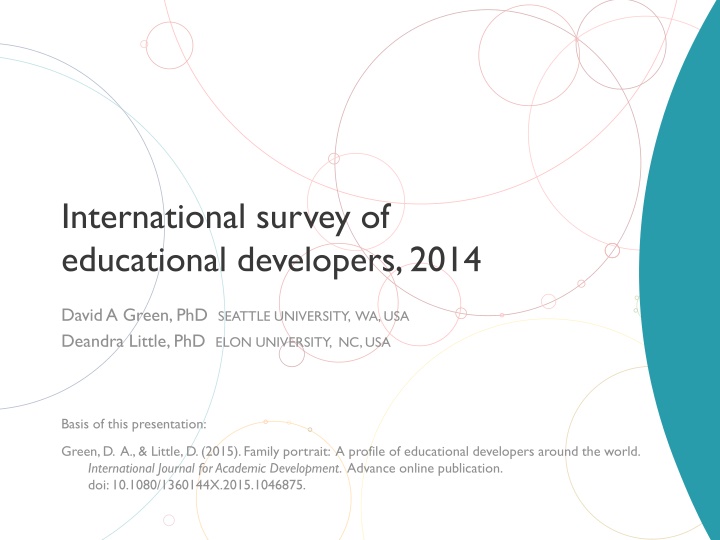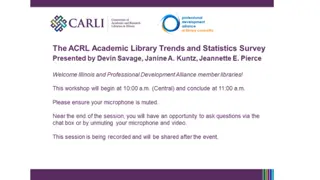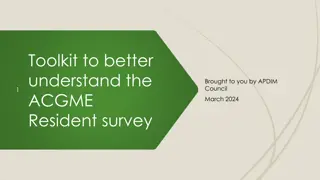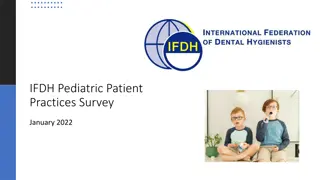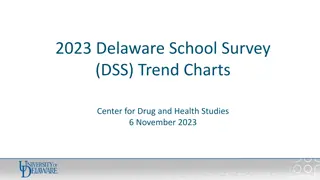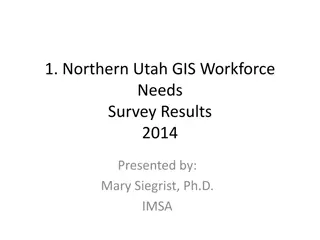International Survey of Educational Developers: Insights and Trends
Explore findings from the 2014 international survey of educational developers, revealing key demographics, institutions, roles, and disciplinary data. Discover insights on gender, age, continental location, and the most valued criteria at educational institutions. The survey offers a comprehensive snapshot of the field, shedding light on global trends and practices in academic development.
Download Presentation

Please find below an Image/Link to download the presentation.
The content on the website is provided AS IS for your information and personal use only. It may not be sold, licensed, or shared on other websites without obtaining consent from the author.If you encounter any issues during the download, it is possible that the publisher has removed the file from their server.
You are allowed to download the files provided on this website for personal or commercial use, subject to the condition that they are used lawfully. All files are the property of their respective owners.
The content on the website is provided AS IS for your information and personal use only. It may not be sold, licensed, or shared on other websites without obtaining consent from the author.
E N D
Presentation Transcript
International survey of educational developers, 2014 David A Green, PhD SEATTLE UNIVERSITY, WA, USA Deandra Little, PhD ELON UNIVERSITY, NC, USA Basis of this presentation: Green, D. A., & Little, D. (2015). Family portrait: A profile of educational developers around the world. International Journal for Academic Development. Advance online publication. doi: 10.1080/1360144X.2015.1046875.
caveats response rates? language? self-selection by topic? (Green & Little, 2015)
1. Demographic data 2. Institutional data 3. Role data 4. Disciplinary data (Green & Little, 2015)
1. Demographic data (Green & Little, 2015)
Who are we? Gender, age, and continental location (nearest %; n= 959, 959, and 956 respectively) Female: 70 Europe: 49 North America: 26 GENDER % CONTINENTAL LOCATION % Oceania: 16 Male: 29 Africa: 5 AGE % Asia: 3 aged 30 and under: 5 aged 71 and over: 1 aged 31 40: 22 aged 61 70: 12 aged 41 50: 30 aged 51 60: 30 (Green & Little, 2015)
UK 146 SE 25 IE 13 DK 28 IS 2 NO 1 FI 65 DE 85 NL 3 NL 3 BE 27 Where are we? (n=955) CA 102 EE 4 JP 9 FR 33 CN 2 CH 23 RO 2 HK 2 PK 1 SA 1 IN 10 HR 4 VN 4 HU 1 AT 3 TH 2 SG 1 BD 1 ES 7 PG 1 US 146 ET 1 MA 1 NZ 48 SZ 1 AU 104 ZA 43 (Green & Little, 2015) CL 3
Country comparisons (25+ responses) UK 146 SE 25 DK 28 FI 65 DE 85 NL 3 BE 27* CA 102 FR 33 US 146 NZ 48 AU 104 ZA 43 (Green & Little, 2015)
1. Demographic data 2. Institutional data (Green & Little, 2015) (Green & Little, 2015)
What is most valued at our institutions? Main promotion criteria (n=1101; nearest percentage point) 100 RESPONDENTS (%) 75 50 50 25 19 11 10 6 5 0 Research clear priority Research slight priority Roughly equal Teaching slight priority Teaching clear priority Not applicable MAIN PROMOTION CRITERIA (Green & Little, 2015)
What is most valued at our institutions? Main promotion criteria: Overall average (n=1,101) and country variability (nearest %) 96 100 RESPONDENTS (%) 75 69 62 50 28 25 16 11 8 4 0 0 DENMARK USA OVERALL AVERAGE OVERALL AVERAGE Research priority Roughly equal between research and teaching Teaching priority (Green & Little, 2015)
1. Demographic data 2. Institutional data 3. Role data (Green & Little, 2015)
What are our contractual roles? Overall average (n=974) and country variability (nearest percentage point) OVERALL AVERAGE OVERALL AVERAGE 37 29 29 5 New Zealand 58 19 17 6 South Africa 40 47 9 5 Belgium 19 26 56 0% 100% academic/faculty both academic and administrative administrative/managerial other (Green & Little, 2015)
Who do we teach as part of our jobs? Overall average (n=927) and country variability (nearest percentage point) 96 100 89 88 87 79 79 78 78 74 75 RESPONDENTS (%) 67 63 63 53 50 50 47 47 45 50 44 41 40 39 37 37 36 36 34 33 32 29 27 27 20 20 25 17 15 0 Australia Canada Denmark Finland France Germany New Zealand South Africa Sweden UK USA OVERALL AVERAGE AVERAGE OVERALL Teach undergraduates Teach (post)graduates Teach academics/TAs (Green & Little, 2015)
Do we conduct research per se? Overall average (n=939) and country variability (nearest percentage point) 96 95 93 100 88 87 85 84 82 78 21 75 74 22 28 23 75 RESPONDENTS (%) 63 29 27 40 24 18 40 29 25 50 75 72 67 64 57 56 55 54 25 48 45 44 38 0 Australia Canada Denmark Finland France Germany New Zealand South Africa Sweden UK USA OVERALL AVERAGE AVERAGE OVERALL Researches as part of role Researches outside role (Green & Little, 2015)
1. Demographic data 2. Institutional data 3. Role data 4. Disciplinary data (Green & Little, 2015)
What are our highest qualifications? Overall average (n=1,045) and country variability (nearest percentage point) 100 89 82 USA RESPONDENTS (%) 75 59 OVERALL AVERAGE 50 37 25 11 BELGIUM 19 4 0 0 bachelor's/post-bachelor's master's/post-master's doctorate/habilitation HIGHEST ACADEMIC QUALIFICATION (Green & Little, 2015) (Green & Little, 2015)
What are our academic backgrounds? Broad field of highest degree: Overall average (n=1,039) and country variability (nearest %) OVERALL AVERAGE OVERALL AVERAGE 34 20 20 16 4 5 2 52 14 13 14 2 2 4 Australia 1 24 6 15 46 3 6 France 32 18 29 18 4 Denmark 0% 100% Professional fields Humanities Social Sciences STEM Health Sciences Transdisciplinary Fine Arts Other business, education, law philosophy, literature anthropology, psychology sciences, technology, engineering, mathematics medicine, nursing, speech pathology graphic design, music EXAMPLES (Green & Little, 2015)
What are our most common disciplinary backgrounds? Highest degree 20 or more cases (n=1,039; nearest percentage point) Education 23% Transdisciplinary 5% Psychology & cognitive science 5% Literature 5% Higher education 5% Linguistics 3% Educational Technology & Distance Ed 3% Philology & cultural studies 3% Business & management 3% Interdisciplinary 2% History 2% Adult & professional education 2% Sociology 2% Geography & earth/planetary sciences 2% Computer science 2% 0% 5% 10% 15% 20% 25% (Green & Little, 2015)
Questions greend@seattleu.edu dlittle@elon.edu
